I got the sled (or platform) built that will move the drill up and down (Z axis) in my CNC machine. I spent over a week trying to figure out how to make thrust (axial load) bearings for the lead screw, so that all of the motor’s rotary motion is translated into vertical movement of the drill, not vertical movement of the screw itself. I’m still not completely sure that my plan for that will work, but at least I have something to try in the next stage I’m going to build.
I need to find and learn to use an open-source 3D CAD program; but meanwhile, I laid this out in OpenOffice Draw. I had started by tracing the different pieces onto graph paper by hand; but the design didn’t really pick up steam until I got them into the computer, where I could drag and resize components easily. Several times when I thought I was done, I saw the opportunity to shrink things a little closer together — which ultimately translates into the capacity to work a larger piece, as less of the length of the guide rods is consumed by the width of the sled.
Here’s my final design — final for the prototype machine, anyway. And here’s what it looks like in the physical world — a pretty close match.
The drill is held by two square blocks with round holes drilled out in their centers. I goofed and cut the blocks to 2 1/4″ instead of 2 1/8″, so the whole platform now fits together a little tightly, and the alignment of the guide rod on the left is a little off; I’ll have to compensate for that later on. And the drill fits a little loosely in the holes because they’re a bit too large, but I’ll add some thin weatherstripping to grip the drill tightly.
The white blocks on the right are built up from two layers of polypropylene kitchen cutting board, superglued together, with a hole tapped through lengthwise for the threaded rod (1/4″ all-thread). When the rod turns, it will push the drill down or pull it back up.
On the left are a bearing glide and stainless steel rod salvaged from a workhorse IBM dot-matrix printer. A computer surplus store in Wichita had a closing sale a few years back, and when no one bought the printers, the owner suggested that I haul them off. I dutifully removed all the electronics, boxed up the mechanical components, and deposited the plastic for recycling. At last the mechanics are finding a new use. ![]()
This assembly will be oriented with the drill pointing down, and a frame will surround it in the Y-Z (vertical) plane. The frame is shown in the drawing but not in the photograph; it’s the next piece to be constructed. The frame will anchor both ends of the guide rod and the lead screw, provide a mount for the motor, and mount two glide assemblies to move the entire frame sideways in the Y (short horizontal) axis.
Motor Mounting
The motor isn’t mounted to the screw right now, since it mounts from the outside of the (yet-to-be-constructed) frame. But I’ve been looking for a good coupler to join the motor shaft to the threaded rod. The ideal coupler would help compensate for slight misalignment between the axes of the motor and the rod, but really good couplers seem to cost $60-$80.
I’ve found one at Jameco that’s much more affordable (just under $5) and looks like it’ll do the job nicely. It has a rubber “spider” enclosed between two pronged pieces. The spider has a little bit of “give” to it, to correct for misalignment. It should also help damp transmission of noise and vibration between the motor and the screw.
Meanwhile, I’ve built a cheapo prototype coupler myself. I got a $1.49 threaded coupler from Ace Hardware, drilled out half of it to 1/4″, and drilled and tapped holes for set screws. I pressed the drilled end onto the motor’s shaft, filed a flat into the threaded rod and turned it in to the threaded end, and tightened the two set screws. I need to file off some of the set screws’ length, but it’s working okay for a proof of concept.
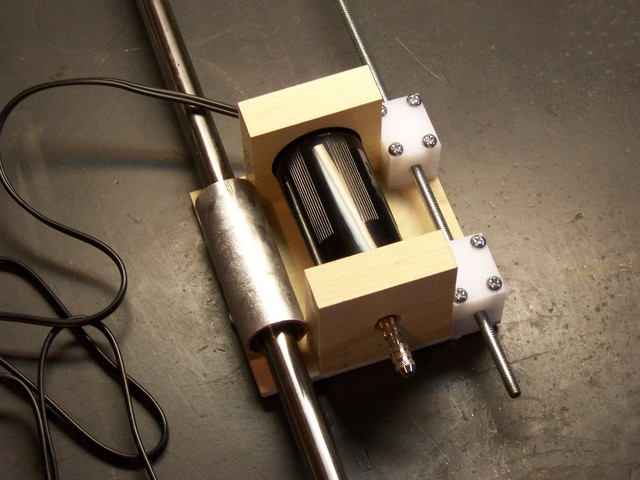
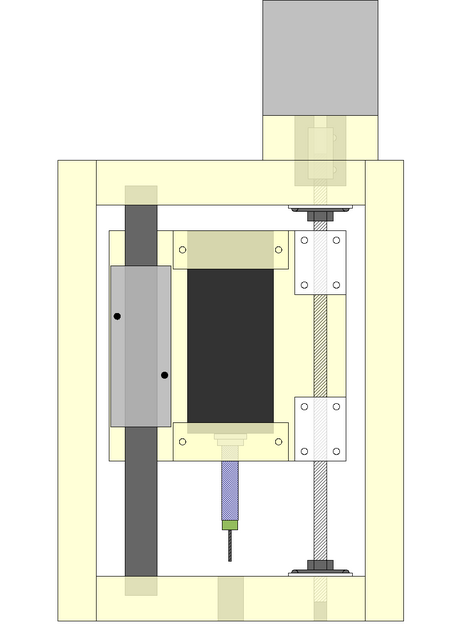
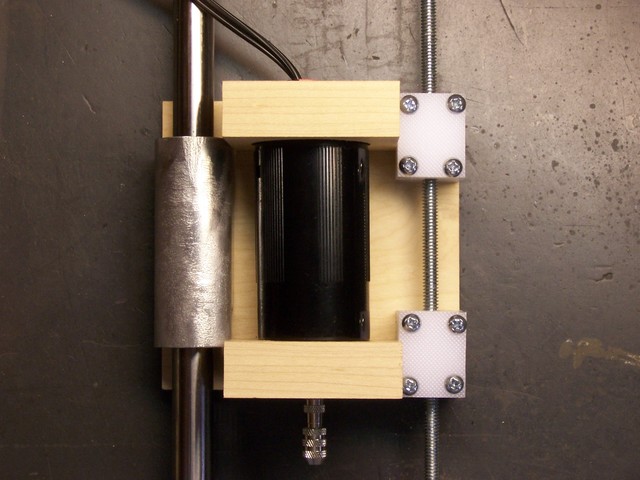
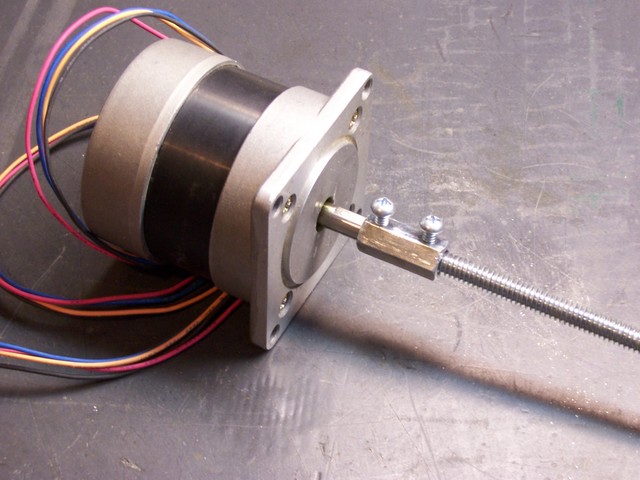
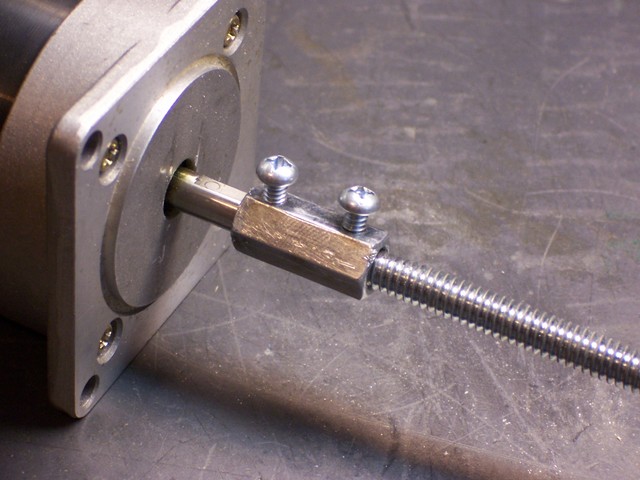
What are you doing? Your trying to use the drill rod as a guide. And you’ve got it clamped in two places. I guess your planning to have your alignment perfect. You might find out why they charge $80 for a coupler. Why did you put 4 screws in your nylon blocks. How are you going to align that. Why didn’t you use the couplers instead of the nylon. Is that one of those cheap roto tools with the sloppy bearings.
You know I did some blogs and I never get any comments.
from where do you get that lead screw i also need it in some other project please let me know in which apparatus i can get that
Aryan, the lead screw is available at any (US) hardware store, called all-thread. It’s a piece of rod with threads along its entire length, like a long, headless bolt. Mine cost less than $10 for a three-foot length, which is enough for at least two of my axes.
I use 1/4-20 (1/4″ diameter, 20 threads per inch) because 20 tpi divides nicely into 1000. My circuit boards are laid out in mils (thousandths of an inch), so I want to be able to address 1/1000″ exactly — not a nearby size like 1/800″ or 1/1024″.
Since my motor has 200 steps per revolution, threaded rod with 5 tpi gives me 1000 addressable steps per inch. Any integer multiple of 5 tpi gives me an integer multiple of 1000 steps / inch, so I needed rod with a multiple of 5 tpi.
Of the sizes available at my local hardware store, 1/4-20 was the only multiple of 5 tpi, so it was my choice. That gives me 4000 steps per inch, which is pretty fine-grained control (ignoring backlash and other mechanical shortcomings).
how you fixed the guide block which the rod move on it
in the plate the
i trying to build x-axis and y axis to my cnc router machine
and other question how you can calculate the steps of the motor
Mohamed, I’m sorry, but I’m not sure what you’re asking.
check this photo
http://img249.imageshack.us/img249/6279/1002569mid.jpg
Mohamed, screws from the back side into the thickness on each side of the rod.
thanx for the replay
sorry i am not familier with this mechanical stuff
check the photo
http://img186.imageshack.us/img186/2818/drillplatformfront.png
can u give me the photo of ur machine ???
Mohamed, I haven’t finished the machine; all of it that’s built is what you see above.
The shaft coupler is what I show and describe in my blog post. The other parts you indicate in your annotations were an idea about how to keep the shaft from moving axially within the frame, and aren’t actually working as desired and have been removed.